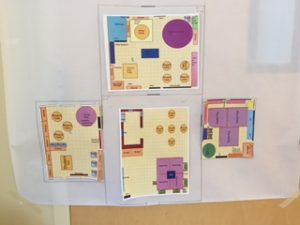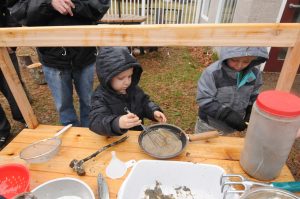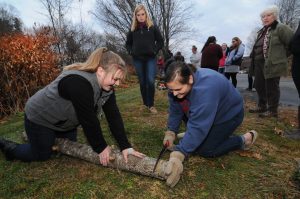Summer is a great time for children to play, hangout with one another, and learn while having fun! It can be hard keeping children occupied and entertained all of the time, especially on these long summer days off. Here are some different activities, indoors and out, messy and neat, that can be done with one child or multiple children:
Go for a nature walk- Nature walks are a great way to get outside and get moving. It gives children an  opportunity to explore, ask questions, discover, and learn. Nature walks can have a purpose or a goal, such as finding as many birds as possible, or it can simply be taking a relaxing, quiet stroll together. Nature walks can be as busy or relaxing as you want!
opportunity to explore, ask questions, discover, and learn. Nature walks can have a purpose or a goal, such as finding as many birds as possible, or it can simply be taking a relaxing, quiet stroll together. Nature walks can be as busy or relaxing as you want!
Paint with leaves– While on that nature walk, it might be a good idea to collect some sticks and various leaves, pine needles, etc. These items can be attached to the end of the stick with a rubber band and used as a paintbrush! Using a variety of materials will give children different textures and patterns and allow them to creatively express themselves while exploring new materials.
 Water balloon fun– Water balloons are a fun way to cool off on those hot summer days, and there are plenty of games that can be played! Have you ever heard of water balloon baseball? It’s just as fun as it sounds! Other games can include catch, tag, or just a free for all water balloon fight! Whatever you do with the water balloons, children are sure to have a blast!
Water balloon fun– Water balloons are a fun way to cool off on those hot summer days, and there are plenty of games that can be played! Have you ever heard of water balloon baseball? It’s just as fun as it sounds! Other games can include catch, tag, or just a free for all water balloon fight! Whatever you do with the water balloons, children are sure to have a blast!
 Tie-dye- Tie-dyeing gives children an opportunity to create something themselves. They can create various patterns and observe their creative process at work. You can tie-dye shirts, socks, sheets, towels, hats, shorts, anything really! For various tie-dye patterns, click here.
Tie-dye- Tie-dyeing gives children an opportunity to create something themselves. They can create various patterns and observe their creative process at work. You can tie-dye shirts, socks, sheets, towels, hats, shorts, anything really! For various tie-dye patterns, click here.
Homemade Play-Dough- Again, why spend the money on store bought Play-Dough when children can help make it at home? This recipe allows for you to chose your own colors and choose how sticky or dry the dough is. For a full recipe on how make Play-Dough using Kool-Aid, click here. You can find tons of variations using other ingredients online as well- have fun!
Ice cream in a bag- Why spend the money at an expensive ice cream  shop when you can make your own ice cream right at home? This recipe requires a few simple ingredients such as milk, cream, ice, rock salt, sugar, and any other flavorings or toppings you want! Children can easily assist and participate in the ice cream making process, and it tastes so good! For a complete recipe, click here.
shop when you can make your own ice cream right at home? This recipe requires a few simple ingredients such as milk, cream, ice, rock salt, sugar, and any other flavorings or toppings you want! Children can easily assist and participate in the ice cream making process, and it tastes so good! For a complete recipe, click here.
 DIY bird feeders- Children will love watching birds and squirrels come up and eat off of the bird feeder that they helped to make. It is a fun and easy process that any child can participate in. These cookie cutter bird feeders can be hung anywhere and can be personalized to various shapes! For the full recipe, click here. DIY bird feeders also be made in various different ways, so click here for more examples and styles of bird feeders.
DIY bird feeders- Children will love watching birds and squirrels come up and eat off of the bird feeder that they helped to make. It is a fun and easy process that any child can participate in. These cookie cutter bird feeders can be hung anywhere and can be personalized to various shapes! For the full recipe, click here. DIY bird feeders also be made in various different ways, so click here for more examples and styles of bird feeders.
Messy Twister– Turn an old, family fun game into a messy work of art outside! Kids will love getting messy with this one, and the clean up can be just as fun if you use a hose! Simply pour non-toxic paint on the Twister mat on each of the circles. Every time someone has to place their hand or foot down, they will be putting it in paint and slipping all around, getting covered from head to toe in paint! What a fun, silly way to play Twister!
Kids will love getting messy with this one, and the clean up can be just as fun if you use a hose! Simply pour non-toxic paint on the Twister mat on each of the circles. Every time someone has to place their hand or foot down, they will be putting it in paint and slipping all around, getting covered from head to toe in paint! What a fun, silly way to play Twister!
Sidewalk chalk- The sidewalk chalk possibilities are endless! Chalk can be used outdoors for many things. Turn the ground into a studio, and draw some chalk art that can be used as a backdrop in a fun photoshoot! Or use the chalk to play a game like hopscotch or 4-square. Children can be occupied for hours as they let their imagination flow with the chalk!
Scavenger hunt- Scavenger hunts can be fun and designed for anywhere! Children can do an outdoor scavenger hunt looking for things such as ladybugs, blue flowers, or a rock shaped like a heart. Or they can do a scavenger hunt in the grocery store, looking for something that costs $3.99, something with the word “nut” in the name, and a red vegetable. You can make a scavenger hunt for anywhere including around the house, walking around town, the backyard, the beach, etc. Kids will love exploring and finding these  items!
items!
Finding activities that make all children happy can be a challenge, but these activities can be altered and modified to meet the needs and abilities of all children! Whether you are a parent, a babysitter, an older sibling, a teacher, or a camp counselor, we hope you have a wonderful summer and enjoy it with the children you spend it with!






